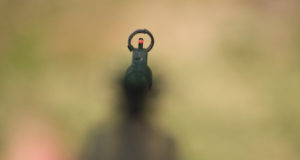|
Listen To The Article
|
 Your semi-automatic battle rifle is a relatively close-range instrument that will probably see the most use inside of 100 yards – in many cases, far less than that. Modern battle has seen the military switch from relatively long-range engagements to short-range, close-quarters battles that happen from house to house. Almost across the board, modern militaries have adopted close-range, unmagnified red-dot or holographic sights to aid in rapid target acquisition during close quarters battle.
Your semi-automatic battle rifle is a relatively close-range instrument that will probably see the most use inside of 100 yards – in many cases, far less than that. Modern battle has seen the military switch from relatively long-range engagements to short-range, close-quarters battles that happen from house to house. Almost across the board, modern militaries have adopted close-range, unmagnified red-dot or holographic sights to aid in rapid target acquisition during close quarters battle.
The American public is still catching up to this trend, but even so, it’s not unusual to see an AR-pattern rifle with a magnified scope mounted on it. It’s one thing to build a dedicated AR-pattern varmint gun with a twenty-four-inch bull barrel and mount a variable power scope to it – it’s quite another to mount such a scope on a sixteen-inch-barrel battle rifle.
Irons and Scopes
For years, hunting rifles had either iron sights (rare) or a scope mounted to them. Iron sights, in the hands of a capable shooter, are perfectly good out to 300 yards, and sometimes, much more, depending on the shooter. The problem they have is that the front sight post itself tends to obscure the target even at relatively short ranges. A scope eliminates this problem – the cross hairs are fine enough to neatly rest on targets that are hundreds of yards away. Scopes aren’t without their own problems, and one of their greatest is field of view: the stronger the magnification, the narrower the field of view. This results in the occasional missed shot—you see the target with your eye, then look through the scope, and suddenly you can’t see the target. You swing around, trying to fix it, but the magnification on your scope is your undoing in that instance.
How to hide your guns, and other off grid caches… [1]
Naturally, when AR-pattern rifles (as well as other military style rifles) came on the scene, the American shooter basically went with what he knew best—scopes or irons, both of which aren’t the best choice for this type of rifle.
Holographic and Red Dot Sights
In order to understand why holographic and red dot sights are the best choice for a battle rifle, you need to understand how they work and what they are. Without going into too much scientific detail about minutes of angle or field of view, understand that the basic concept is an unmagnified sight with a wide field of view upon which is projected either a dot or a reticle of some sort. Let’s break these pieces apart for easier consumption:
Unmagnified sight: This is an important distinction. Remember, when most people think of an optic on a rifle, they think in terms of magnification. Magnification, however, reduces the field of view, narrowing what you can see. It also serves no purpose at the ranges where your rifle will most likely be used in.
Wide field of view: Holographic and red dot sights such as the EOTECH and Aimpoint sights have a very wide, open field of view. If looking through a scope is like looking through a roll of toilet paper, then looking through an EOTECH is like looking through something the size of a credit card. It’s like widescreen for your scope. The form factor is different, and the result is rapid target acquisition. Gone are the days of losing the target in your scope.
Dot or reticle: A red dot is just that: a red dot. A reticle is a fancy term for a design imprinted upon the sight’s field of view. It could be a circle, it could be crosshairs, or it could be a combination of the two. The beauty of these sights is thus: simply put the red dot or the reticle on the center mass of the target and pull the trigger! In fact, it’s beyond simple. No knobs to adjust, no front and rear sight to align, nothing. Red dot, center mass, end of story.
The beauty of these sights is their simple target acquisition and ease of use. Once the sight is zeroed, set it and forget it. Battery life on these is also not a factor – an Aimpoint red dot sight can go something like 8,000 hours with a tiny lithium battery, meaning that you can probably even leave the sight on at all times. Additionally, the sights can be dialed up for intensity.
One final factor needs to be considered here. These sights are parallax free. That means that parallax, or the shift in the point of impact due to the construction of the sight, is not a factor here. That’s a huge feature for the operator, because it means that regardless of what angle you look through the sight, the dot will always signify the point of impact. Pick up your rifle, put the red dot on the bad guy’s chest, and fire away. That’s how simple red dots and holographic sights are, and that’s why they’ve been adopted in law enforcement agencies and militaries around the globe.
©2013 Off the Grid News
